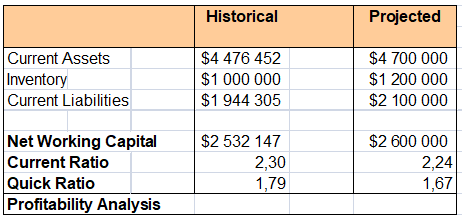Running a restaurant, especially in the area known for its high competition rates among the local food production companies, particularly, the fast food industries, is not an easy task. However, by defining the profits and losses that the company is likely to witness in the first year of its operation within the specified area, one can identify the existing threats at the earliest stages of business development and, therefore, avoid them in the future.
The following Projected Profit and Loss Statement shows that organizing a restaurant business in the area, where fast food industries appear to have rather big influence, may turn out to be quite successful.
The information provided above shows in a very graphic manner that the restaurant is going to thrive in a rather threatening environment. On the one hand, the current assets of the company are quite high, with the budget allowing for the introduction of the latest equipment and renting rather large premises.
On the other hand, the increasing competition rates and the necessity to come up with a unique marketing campaign create a rather unsettling situation (Koutroumanis, 2011). It is assumed that, by making reasonable cuts for certain facilities, such as the advertisement tools, the company will be able to create the environment for delivering the services of the finest quality.
For the restaurant business to be successful, it is imperative to take the start-up costs into account (Enz, 2010). Traditionally, several types of costs are identified in regard to the aspect of restaurant business considered. It is expected that a restaurant chain, which is going to compete with major fast food services, will have to take the following costs:
When identifying the future costs and setting certain expectations for the amount of money required to cover them, one must keep in mind alternative options. For example, the insurance costs, which have been mentioned above, may be reduced to a considerable extent by creating a merger with a partner company and, therefore, splitting the risks (Rejda & McNamara, 2014).
In addition, when defining the insurance strategy for the specified type of business, one must take a comparatively large amount of staff into account. Therefore, compiling a Managed Care Plan (Rejda & McNamara, 2014, p. 304) seems the most adequate solution for the company to adhere to.
In addition, as far as the marketing issue is concerned, one must admit that there are a variety of ways to reduce the amount of costs spent on the promotion process. First and most obvious, the efficacy of social networks and the related services must be born in mind.
For example, as the table provided above shows, the company is going to spend an impressive sum on the arrangement of the opening event; hence, creating an additional promotion campaign in order to draw public’s attention to the opening night does not seem reasonable from a financial point of view.
Therefore, instead of using the standard technique and putting a major emphasis onto the traditional media as the key promotion tool, it seems more acceptable to incorporate modern media into the promotion process.
E-marketing can be used as one of the key tools for drawing people’s attention to the opening of the restaurant; both direct e-marketing (i.e., sending e-mail invitations) should be mixed with indirect one (e.g., announcements in social networks, etc.)
When it comes to the choice of an appropriate social network, Facebook and Pinterest appear to be the best choices in terms of cost reduction and the speed and the scale of information transfer. The assumptions for the first year of running the restaurant and the associated costs are provide below:

By reducing the amount of total liabilities, it will be possible to increase the net profit margin considerably. The return on investment is expected to be somewhat lower than in the previous year. However, a more appropriate insurance strategy, which can be achieved by merging with another business and splitting the liabilities, will create the premises for an increase in the total assets of the company.
Reference List
Enz, C. A. (2010). Competitive dynamics and creating sustainable advantage. In C. Enz (Ed.), The Cornell School of Hotel Administration handbook of applied hospitality strategy (pp. 297-305). Los Angeles, CA: SAGE.
Koutroumanis, D. A. (2011). Technology’s effect on hotels and restaurants: Building a strategic competitive advantage. Journal of Applied Business and Economics, 12(1), 72–80.
Rejda, G. E. & McNamara, M. J. (2014). Principles of Risk management and insurance (12th ed.). Upper Saddle River, NJ: Pearson.